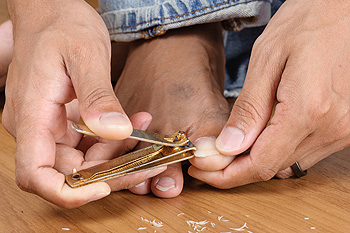Why Do I Have an Ingrown Toenail?
Monday, 16 March 2020 00:00 When the toenail grows into the flesh instead of over it, it is referred to as an ingrown toenail. The big toe is usually the most common to become affected. This condition can be particularly painful and may lead to an infection if left untreated. To help prevent an ingrown toenail, it is recommended that you trim the toenails properly, which is straight across, not on a curve or following the shape of your toe. Additionally, toenails should not be trimmed too short. Symptoms associated with ingrown toenails generally include swelling and redness around the affected area. Additionally, for more severe cases, you may notice bleeding or oozing of pus, which can be an indication that an infection has developed. To safely treat an ingrown toenail it is suggested that you consult with a podiatrist.
When the toenail grows into the flesh instead of over it, it is referred to as an ingrown toenail. The big toe is usually the most common to become affected. This condition can be particularly painful and may lead to an infection if left untreated. To help prevent an ingrown toenail, it is recommended that you trim the toenails properly, which is straight across, not on a curve or following the shape of your toe. Additionally, toenails should not be trimmed too short. Symptoms associated with ingrown toenails generally include swelling and redness around the affected area. Additionally, for more severe cases, you may notice bleeding or oozing of pus, which can be an indication that an infection has developed. To safely treat an ingrown toenail it is suggested that you consult with a podiatrist.
Ingrown toenails may initially present themselves as a minor discomfort, but they may progress into an infection in the skin without proper treatment. For more information about ingrown toenails, contact Dr. Stephen Petrofsky of Florida. Our doctor can provide the care you need to keep you pain-free and on your feet.
Ingrown Toenails
Ingrown toenails are caused when the corner or side of a toenail grows into the soft flesh surrounding it. They often result in redness, swelling, pain, and in some cases, infection. This condition typically affects the big toe and may recur if it is not treated properly.
Causes
- Improper toenail trimming
- Genetics
- Improper shoe fitting
- Injury from pedicures or nail picking
- Abnormal gait
- Poor hygiene
You are more likely to develop an ingrown toenail if you are obese, have diabetes, arthritis, or have any fungal infection in your nails. Additionally, people who have foot or toe deformities are at a higher risk of developing an ingrown toenail.
Symptoms
Some symptoms of ingrown toenails are redness, swelling, and pain. In rare cases, there may be a yellowish drainage coming from the nail.
Treatment
Ignoring an ingrown toenail can have serious complications. Infections of the nail border can progress to a deeper soft-tissue infection, which can then turn into a bone infection. You should always speak with your podiatrist if you suspect you have an ingrown toenail, especially if you have diabetes or poor circulation.
If you have any questions, please feel free to contact our office located in Port Charlotte, FL . We offer the newest diagnostic and treatment technologies for all your foot care needs.



